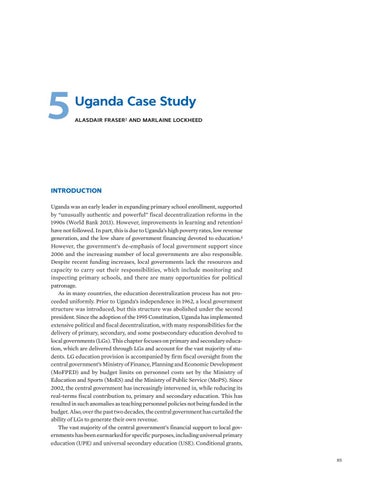5
Uganda Case Study AL ASDAIR FRASER1 AND MARLAINE LOCKHEED
INTRODUCTION Uganda was an early leader in expanding primary school enrollment, supported by “unusually authentic and powerful” fiscal decentralization reforms in the 1990s (World Bank 2013). However, improvements in learning and retention2 have not followed. In part, this is due to Uganda’s high poverty rates, low revenue generation, and the low share of government financing devoted to education.3 However, the government’s de-emphasis of local government support since 2006 and the increasing number of local governments are also responsible. Despite recent funding increases, local governments lack the resources and capacity to carry out their responsibilities, which include monitoring and inspecting primary schools, and there are many opportunities for political patronage. As in many countries, the education decentralization process has not proceeded uniformly. Prior to Uganda’s independence in 1962, a local government structure was introduced, but this structure was abolished under the second president. Since the adoption of the 1995 Constitution, Uganda has implemented extensive political and fiscal decentralization, with many responsibilities for the delivery of primary, secondary, and some postsecondary education devolved to local governments (LGs). This chapter focuses on primary and secondary education, which are delivered through LGs and account for the vast majority of students. LG education provision is accompanied by firm fiscal oversight from the central government’s Ministry of Finance, Planning and Economic Development (MoFPED) and by budget limits on personnel costs set by the Ministry of Education and Sports (MoES) and the Ministry of Public Service (MoPS). Since 2002, the central government has increasingly intervened in, while reducing its real-terms fiscal contribution to, primary and secondary education. This has resulted in such anomalies as teaching personnel policies not being funded in the budget. Also, over the past two decades, the central government has curtailed the ability of LGs to generate their own revenue. The vast majority of the central government’s financial support to local governments has been earmarked for specific purposes, including universal primary education (UPE) and universal secondary education (USE). Conditional grants, 85






